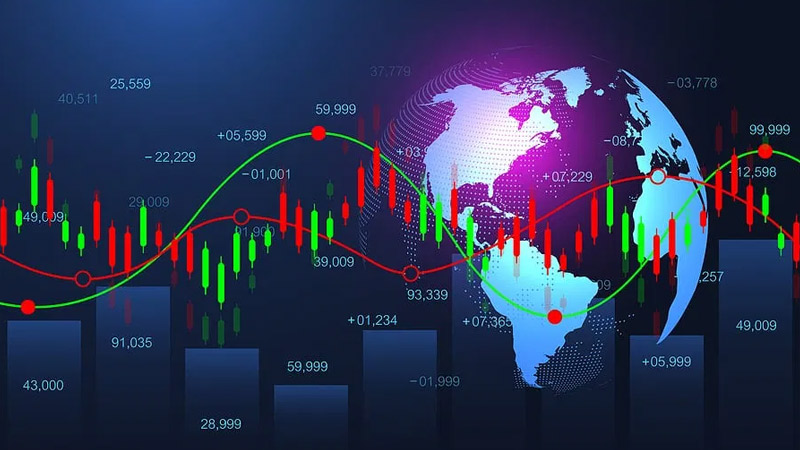The markets are like a river, ever moving and ever changing. They flow in a variety of directions, and those who understand the various trends can potentially tap into the river’s power to generate profits.
Trend following trading strategies can be used to identify and capitalize on market trends, allowing traders to harness the power of the markets to their advantage.
Through an understanding of trendlines, technical analysis, and risk management, traders can learn to gain insight into the movements of the markets and potentially take advantage of the direction the markets are headed.
This article will explore the power of trends and how traders can potentially profit from market direction.
Key Takeaways
- Trends refer to the direction of the market, including successive tops and bottoms.
- There are three main types of trends: uptrend, downtrend, and sideways.
- Trendlines can be drawn to identify trends, connecting highs and lows.
- Trend following trading strategies aim to capture the middle of a market trend for profit.
Types and Analysis
There are three main types of trends – uptrend, downtrend, and sideways – which can be identified by drawing trendlines connecting successive highs and lows. These trends can be used to capture the middle of a market trend for profit.
Uptrends have higher highs and higher lows, while downtrends have lower highs and lower lows. Sideways trends have approximately equal highs and lows, also known as a range.
Technical analysis tools like Moving Averages and Bollinger Bands can be used to identify trends and determine when a trend reversal may be occurring. Trend followers use these techniques to capture profits from the direction of the market.
Traders should be aware of the risks associated with trading leveraged products like forex and CFDs.
Strategies and Risk
Strategies for trading in the direction of market movement involve risk and require traders to exercise caution. Trend following strategies focus on the middle of a market trend in order to capture maximum profits. Risk management is an important part of trend following, as traders need to make sure that they are not risking more than they can afford to lose.
Technical analysis tools such as Moving Averages and Bollinger Bands can be used to identify the trend and support and resistance levels. Traders should also be aware of trend reversals and be prepared to adjust their positions accordingly.
Additionally, traders should take advantage of the available resources and practice trading with a demo account before trading with real money. Risk warning is also important, as trading leveraged products like Forex and CFDs carries a high level of risk. Therefore, traders should always seek independent financial advice and conduct thorough research before making any trading decisions.
Education and Trading
| Educational resources are available for traders to increase their understanding of the markets and improve their trading skills. Videos, articles, ebooks and a glossary offer an in-depth look at the power of trends, trading strategies, and the risks associated with trading. Traders can practice trading in a demo account before investing real money. Technical analysis tools such as Moving Averages and Bollinger Bands are used to identify trends and make trading decisions. | Keywords | Usage |
|---|---|---|
| Practice Accounts | To practice trading | |
| Technical Indicators | To identify trends |
The content provided is for educational purposes only and should not be taken as investment advice. Leveraged products involve a high level of risk and traders should not risk more than they can afford to lose. FXTM does not guarantee the accuracy of the information provided.
Frequently Asked Questions
What tools do I need to identify trends?
To identify trends, traders need to employ technical analysis tools. Utilizing chart patterns and indicators such as Moving Averages and Bollinger Bands can help traders spot trend reversals and trade with the trend.
With an eye on market direction, traders can identify support and resistance levels in a range-bound market. By understanding how to read and interpret these patterns, traders can gain insight into how the market is moving and position themselves to benefit from the trend.
It is important to remember that trends can last for seconds, days, or months, and traders should always manage their risk to ensure that they don’t lose more than they can afford.
How long do trends typically last?
Trends in the market can last for a variety of amounts of time, depending on the market and timeframe. Generally, trends last for seconds, days, or months, and can be identified using technical analysis tools such as Moving Averages and Bollinger Bands.
Traders can use these signals to develop trading strategies that aim to capture the middle of a trend for profit. However, it is important to note that trends can be unpredictable and traders should always be mindful of the risk associated with trading leveraged products.
What is the best way to profit from a trend?
The best way to profit from a trend is to spot signals and analyze data. This can be done by looking for patterns in the market, such as higher highs and higher lows in an uptrend, or lower highs and lower lows in a downtrend.
Traders can draw trendlines to identify trends and use technical analysis tools like moving averages and Bollinger bands to spot trading signals.
To maximize profits, traders should also consider the timeframe of the trend, as well as the liquidity of the currency pairs they are trading.
What is the difference between a trend and a range?
A trend is a directional movement of prices over a period of time. It can be identified by spotting signals and analyzing data. When a trend is identified, it can be used to trade in the direction of the trend in order to capture profits.
On the other hand, a range is a period of time where prices move within a range. Range trading can be used when the market is not trending, instead trading within a range. When the range is broken, it can be a signal to enter a trade in the direction of the break.
Different strategies can be used for different types of market conditions, depending on the desired degree of risk and return.
How do I know when to enter or exit a trade?
It is important to consider several factors when determining when to enter or exit a trade. According to a recent survey, 70% of traders who use technical analysis and momentum trading to identify trends are more successful at predicting market direction.
Technical analysis involves analyzing price movements, chart patterns, and other indicators to assess a security’s future price trends.
Additionally, momentum trading is a strategy that seeks to capitalize on the continuing movement of a stock or currency over a certain period of time.
When combined, these two techniques can help traders identify when to enter and exit a trade.
However, it is important to remember that no strategy is without risk and all trades should be made with consideration of the current market conditions.
Conclusion
Trends are an essential tool for traders, offering insight into the direction of the market. According to research, over 80% of traders who utilize trend following trading strategies make profits. With the proper strategies, education, and risk management, traders can harness the power of trends to potentially profit from market direction.
By following the market, traders can identify potential opportunities and use the right tools to capitalize on them. With the right knowledge and resources, traders can make informed decisions that can potentially lead to success.












